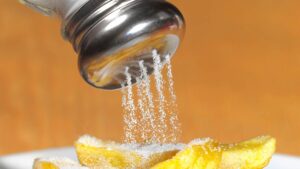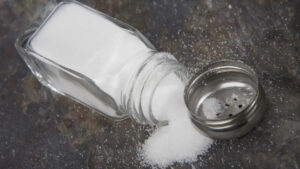These premium-grade potash plays are forging ahead as demand remains strong

Australian SOP plays are skating ahead with their respective projects Pic: Getty Images
Demand for premium-grade fertiliser remains strong and at the same time those producing the key ingredient — sulphate of potash (SOP) — have been able to continue advancing their projects because agriculture has been largely exempt from lockdown policies.
But there isn’t just one type of potash. This sometimes makes it difficult for investors to realise the value proposition of the players that produce the premium-grade SOP.
So just what makes SOP favoured for ‘high value’ food crops?
For starters, SOP provides both potassium and sulphur – key elements required for the healthy growth of plants – in a soluble form.
It also contains no chloride, making it suitable for leafy, chloride-intolerant crops that are typically high-value – such as avocados, increases their yield and minimises the amount of water required.
SOP is also suitable for use in soils that have high salinity or where the irrigation water may have high chloride levels.
Salinity is of particular concern in Western Australia with more than 1 million hectares of agricultural land being severely affected by salt, resulting in lost agricultural productivity of at least $519m per year.
Danakali (ASX:DNK) senior manager corporate development and investor relations Mark Riseley told Stockhead the price premium was due to the fact that it is a key chlorine-free, multi nutrient potash essential for chlorine sensitive, high value, high yield crops such as fruit, nuts, vegetables, tea and coffee.
This includes potassium, which is an essential non-substitutable nutrient for plant growth, and sulphur, which is an essential constituent of protein and involved in the formation of chlorophyll.
SOP typically commanded between $US450 ($627) and $US600 per tonne between January 2014 and January 2020 — about double that of MOP, which traded between $US200 and $US300 a tonne during the same period.
“Current demand is growing at a 2.4 per cent CAGR (compound annual growth rate) on a production base of 7 million tonnes per annum, excluding China, which consumes most of its internal production,” Riseley added.
Additionally, SOP produced by primary producers such as Danakali and its peers is environmentally friendly compared to secondary production using the Mannheim processes, which produces significantly more carbon dioxide and hydrochloric acid that must be disposed off.
Riseley believes these factors could account for why primary SOP producers have had little trouble securing offtake agreements.
SOP project development well underway
Kalium Lakes (ASX:KLL) is well on its way towards production with construction of the Beyondie project in Western Australia over 50 per cent complete at the end of July.
The company noted earlier this month that brine supply infrastructure for Sunshine Lake was well advanced, while construction of village expansion and non-processing infrastructure was near completion.
Construction has also started on the SOP purification plant.
Beyondie has a 5.1-million-tonne ore reserve and a binding offtake agreement with K+S that is expected to deliver revenue of around $650m over the first 10 years.
Kalium Lakes (ASX:KLL) share price chart
Construction imminent for these potash plays
Meanwhile, Danakali has already raised $250m of the $322m it requires for the Module 1 development at its flagship Colluli SOP development in Eritrea and is looking to close the funding gap prior to starting construction early next year.
“We have completed phase one and two of the development process in preparation for the next phase,” Riseley told Stockhead.
“A number of project optimisation processes have been identified and test work analysis completed.”
Colluli has massive scale given that its 1.1 billion tonne ore reserve could keep the project going for a mine life of almost 200 years.
Mining is simple as the orebody starts just 16m from surface, allowing the project to be delivered as an open cut pit. Processing is also straightforward as the ore is geologically ‘simple’, resulting in a turn around time from mining to a finished SOP product of just a couple of weeks.
This places Colluli at the bottom of the global cost curve.
Danakali has already locked in a binding 10-year offtake agreement with leading global fertiliser company EuroChem for the 472,000 tonnes per annum (tpa) of SOP that Module 1 is expected to produce.
The project is expected to deliver cashflow of $US85m per annum at full production.
Danakali (ASX:DNK) share price chart
Salt Lake Potash (ASX:SO4) is also closing in on raising the funds it requires to bring its Lake Way project in WA’s Goldfields region into production. The company has raised $71m through the institutional component of its fully underwritten $98.5m share placement.
The remaining retail component of the offer is expected to close on August 25, 2020.
Together with a $US138m debt financing package, the company is fully funded to bring Lake Way project into production on schedule with first SOP expected in the March quarter of 2021.
Lake Way is expected to produce 245,000tpa of SOP, generating after tax free cash flow of $78m each year.
Salt Lake Potash (ASX:SO4) share price chart
Earlier stage potash projects also making rapid progress
Meanwhile, Australian Potash (ASX:APC) has executed a fourth offtake agreement with HELM for the supply of 30,000tpa of SOP from its Lake Wells project in WA, bringing its total offtake to 130,000tpa, or about 85 per cent of its proposed 150,000tpa output.
The company is also progressing approvals for its project with the Environmental Protection Authority, and the financing program – including funding from the Australian government’s Northern Australia Infrastructure Facility (NAIF) — moving into due diligence.
Lake Wells is expected to produce 150,000tpa of SOP over its 30-year mine life.
BCI Minerals (ASX:BCI) has already signed 13 non-binding salt offtake memoranda of understandings (MoU) and two SOP MoUs with Asian buyers for the sale of 75 per cent of SOP production from its Mardie salt and potash project on WA’s West Pilbara coast.
Discussions with potential cornerstone equity investors are underway, while project funding initiatives such as the NAIF are also well progressed.
The recent DFS envisages production of 4.4 million tonnes of high purity salt and 120,000 tonnes of SOP per annum.
It is expected to deliver total revenue of $22bn and net cash flow of $10bn over 60 years.
Other companies progressing premium-grade potash projects include Agrimin (ASX:AMN), Reward Minerals (ASX:RWD) and Trigg Mining (ASX:TMG).
APC,BCI,AMN,RWD,TMG share price charts
Related Topics
UNLOCK INSIGHTS
Discover the untold stories of emerging ASX stocks.
Daily news and expert analysis, it's free to subscribe.
By proceeding, you confirm you understand that we handle personal information in accordance with our Privacy Policy.








